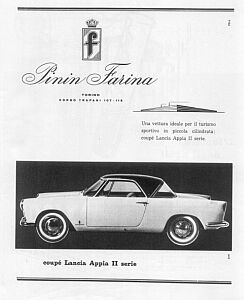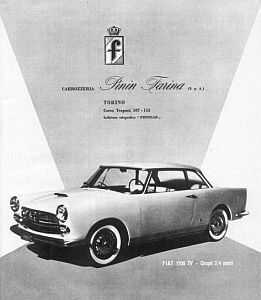Along with two other brothers, Pinin also went to work for the company, despite his young age, and became responsible for the design and publicity. He met many famous and
influential people, and was even offered a job by Henry Ford when travelling in the USA, but opted to return to Turin and get married.
In 1930 Pinin left his brothers company and set up on his own, the Carrozzeria Pinin Farina. He was helped in this move by two people, a rich aunt who assisted financially,
and Vincenzo Lancia who, as well as being a partner in the new firm, promised work and also gave moral support. They began with around 90 employees in a factory at Corso Trapani 107,
making one-off prototypes and very small runs of 5 to 10 special models for direct sale. Predictably the first cars were mainly for Italian companies, Lancia, Fiat, Alfa Romeo, Isotta Fraschini etc,
but 1931 also saw a Cadillac and 1932 a Mercedes Benz passing through their workshops. Around the same time aerodynamics began to emerge as a force and it did not take long for this to influence
the work of Pinin. A 1933 Lancia Astura was one of his earliest aerodynamic designs.
The company continued to expand and become more famous in many countries, by 1939 he employed around 500 people and in that year produced 800 cars. The war
saw all effort turning to military equipment, ambulances, trucks, aeroplane parts, boats and even cookers. 1945 saw Pinin resuming his work without delay. Despite a
fire in 1946 which destroyed the premesis, his creativity was undented, witness the Cisitalia 202 of 1947.
The 1950s saw may significant events for the Carrozzeria Pinin Farina. Work with Nash saw both volume production and a noticeable entrance into the US market,
cooperation began with Peugeot and more famously with Ferrari, and in 1958 the company relocated to a new site at Grugliasco, just outside Turin.
Numerous famous models emerged in these years based on the Lancia Aurelia, Alfa Romeo 1900
and 6C2500, Fiat 1100, 1400 and 1900,
Maserati A6 and many
Ferraris to name but a few. In 1960 alone they produced over 11,000 car bodies, including mass produced bodies for the major manufacturers, small runs of specials
and various concept cars and prototypes.
The family name Farina was changed by deed poll to Pininfarina in 1961 and the company name followed suit. Growth continued, with over 14,000 bodies built in 1962
and nearly 20,000 in the following year. By that time the company was employing over 1,600 people.
In 1966 Battista Pininfarina died and control of the company passed to the already well prepared Sergio (his son) and Renzo Carli (son-in-law). The same year saw a
separate R&D department being established, including the capability to produce complete prototypes. The aim of remaining at the forefront of design technology saw the inaugration in
November 1972 of the Pininfarina windtunnel, the first in Italy and one of the first in the world, which could take a full scale model. With this new facility the 1970s saw a variety of
concept cars developed therein emerge, such as the Ferrari based CR25 of 1974. The fuel crisis of those years also saw early electric powered cars being developed.
A steady stream of both prototypes and mass produced cars left the Pininfarina establishment through the 1970s and 80s. Notable amongst the latter category was
the Fiat 124 Spider, which began production in 1974 and by 1979 had already seen 150,000 being produced. Other notable designs included the Lancia Gamma (saloon and coupe),
Beta Montecarlo, Ferrari 308 and Mondial, whilst the 80s saw Pininfarina diversifying into both
construction machinery, buses and other automotive related fields, and new areas unrelated to the car such as sunglasses.
The next major step for the company came in 1982 when the R&D centre was moved to a new, separate location, and became operationally a separate company.
This became the “Pininfarina Studi e Ricerche SpA” alongside the already formed “Industrie Pininfarina SpA” which was responsible for mass-production.
The 1980s also saw co-operation with Honda start, whilst for the Italian automotive industry, apart from the Alfa 33 Sportwagon, Pininfarina also penned the
slightly more extravagant GTO and Testarossa. In 1987 Pininfarina opened a third site at San Giorgio. Designed primarily to produce the Cadillac Allante it is
located near Turin airport in order to ease the transport of the finished bodies to their US destination, done by airlift.
By 1989 the Pininfarina Group employed 1700 people and produced around 30,000 cars. Arguably the latest stage in their development is the production of
cars which they have not designed, such as the Fiat Coupé, which demonstrates the diversity the group has achieved. Many more cars have Pininfarina influence in
design, development and prototype production than are publicly acknowledged.
 Born in November 1893, Battista Farina was the tenth of eleven children, and was immediately given the nickname ‘Pinin’ which means approximately 'baby of the family’, a nickname
which stuck. Whilst Pinin was very young, Giovanni, one of his elder brothers, became an apprentice to a coachbuilder. He then set up his own workshop, repairing cars and horse
drawn vehicles, which went on to become, in 1917, the well known Stabilimenti Farina.
Born in November 1893, Battista Farina was the tenth of eleven children, and was immediately given the nickname ‘Pinin’ which means approximately 'baby of the family’, a nickname
which stuck. Whilst Pinin was very young, Giovanni, one of his elder brothers, became an apprentice to a coachbuilder. He then set up his own workshop, repairing cars and horse
drawn vehicles, which went on to become, in 1917, the well known Stabilimenti Farina.
Cars (both concept and production, based on Italian cars) by Pininfarina include (this list is not comprehensive) :

| Alfa Romeo 6C2300 'Pescara' Coupe | 1935 |
| Lancia Astura 'Tipo Bocca' | 1936 |
| Lancia Berlinetta Aerodynamica (Aprilia based) | 1937 |
| Alfa Romeo 6C2300 | 1938 |
| Alfa Romeo 6C2500 cabriolet (various) | 1946 & 47 |
| Cisitalia 202 | 1947 |
| Alfa Romeo 6C2500SS coupe | 1947 |
| Alfa Romeo 6C2500 berlinas | 1947 |
| Alfa Romeo 6C2500 Limousine Ministeriale | |
| Alfa Romeo 6C2500 Coupe | 1948 & 50 |
| Fiat 1500 Coupe | 1950 |
| Lancia Aurelia Coupe | 1951 |
| Alfa Romeo 1900 cabriolet | 1951 |
| Alfa Romeo 1900 Coupe | 1953 |
| Lancia PF2000 (Aurelia based) | 1953 |
| Maserati A6 GCS | 1954 |
| Ferrari 375MM Coupe | 1954 |
| Alfa Romeo Giulietta Spider | 1955 |
| Ferrari 250GT Competizione | 1955 |
| Lancia Floride I & II | 1955 & 57 |
| Fiat Abarth 750 Record | 1957 |
| Lancia Flaminia | 1957 |
| Alfa Romeo Spider Super Sport | 1959 |
| Fiat 1200 Cabriolet | 1959 |
| Alfa Romeo 6C 3500 CM | 1960 |
| Ferrarina / ASA prototype | 1961 |
| Alfa Romeo Duetto | 1966 |
| Alfa Romeo 2000 Spider hardtop | |
| Alfa Romeo 2600 Spider & Coupe | 1963 |
| Fiat 1500 & 1600S Spider | 1963 |
| Lancia Flavia Coupe | 1962 |
| Fiat 124 Spider | 1966 |
| Fiat Dino Spider | 1966 |
| Dino 206 GT Special | 1965 |
| Dino Berlinetta Speciale | 1965 |
| Alfa Romeo Giulia 1600 Sport | 1965 |
| Ferrari 365P | 1966 |
| Dino 206SP | 1967 |
| Dino Competizione | 1967 |
| Ferrari P5 | |
| Ferrari P6 | 1968 |
| Ferrari 512S | 1969 |
| Abarth 2000 Prototipo | 1969 |
| PF Modulo | 1970 |
| Ferrari CR25 | |
| Alfa Romeo 33 Spider | 1968 & 71 |
| Alfa Romeo 33 Coupe | 1969 |
| Alfa Romeo Alfetta Spider | 1972 |
| Ferrari Daytona | 1968 |
| Ferrari Berlinetta Boxer | 1971 |
| Ferrari 308 | 1975 |
| Ferrari 365 GT/4 | 1972 |
| Ferrari 400 & 412 | 1976 & 85 |
| Fiat 130 Coupe | 1971 |
| Fiat Maremma (130 estate) | |
| Lancia Beta Montecarlo | 1975 |
| Lancia Gamma berlina & coupe | 1976 |
| Lancia 037 'Rally' | 1982 |
| Lancia Gamma Scala & Oligiata | 1982 |
| Alfa 33 | 1983 |
| Fiat Ritmo 125TC Coupe | 1983 |
| Alfa Romeo 164 | 1988 |
| HIT (Integrale based) | 1988 |
| Mythos (Testarossa based) | 1989 |
| Fiat Song | 1996 |
| Dardo (156 Spider) | 1998 |
| Rossa (550 Maranello based) | 2000 |
most of the above cars can be seen on this site, either on the concept cars page for the manufacturer on which it was based or the model page for the production cars.
[Alfa Romeo Concepts] [Fiat Concepts] [Lancia Concepts] [Ferrari Concepts]
Links
The official Pininfarina website
Comment form
Copyright © 2000 to 2008 CarsfromItaly Use
the buttons at the top to navigate further, or
Use
the buttons at the top to navigate further, or